For two years, I have been carting around a FanTastic Vent Fan in the back of my tow vehicle. Originally, I purchased it before taking off on my first season as a fulltime RVer, in hopes of replacing the one in Wildheart I, my first tiny trailer. But I was in such a hurry to get out of that cramped and inadequate space that I sold it before I had the chance.
Knowing, however, that I’d likely only be able to afford another older trailer, and that most of those did not come with active ceiling fans, I just held onto it, figuring I could use it in my next one. And I was right.
But it wasn’t until the Long Dock for COVID-19 that I had the right combination of enough time and dry, warm weather to actually do the installation. That finall came last weekend.
And—quite unlike my usual behavior—I was in such a hurry to finally get it done, I neglected to take a look at the weather before getting up on the roof. That almost caused a problem.

Fortunately, I was focused enough on the task at hand to remember to put down some plastic sheeting, borrowed from my moochdocking hosts, to protect my bed. It was directly beneath the fan in question, and I didn’t want any of the nasty dirst, bugs and god-knows-what-else to fall into my sheets.
After I finished carefully making sure everything was covered inside, I opened the door to the bright New Mexico sunshine. It was late May, but it was already summer. Out to the west, the sky was bright blue and mostly clear. But off to the north, I could see several cumulonimbus towers already building in the warm morning air. I could feel the relatively greater humidity at the surface than usual.
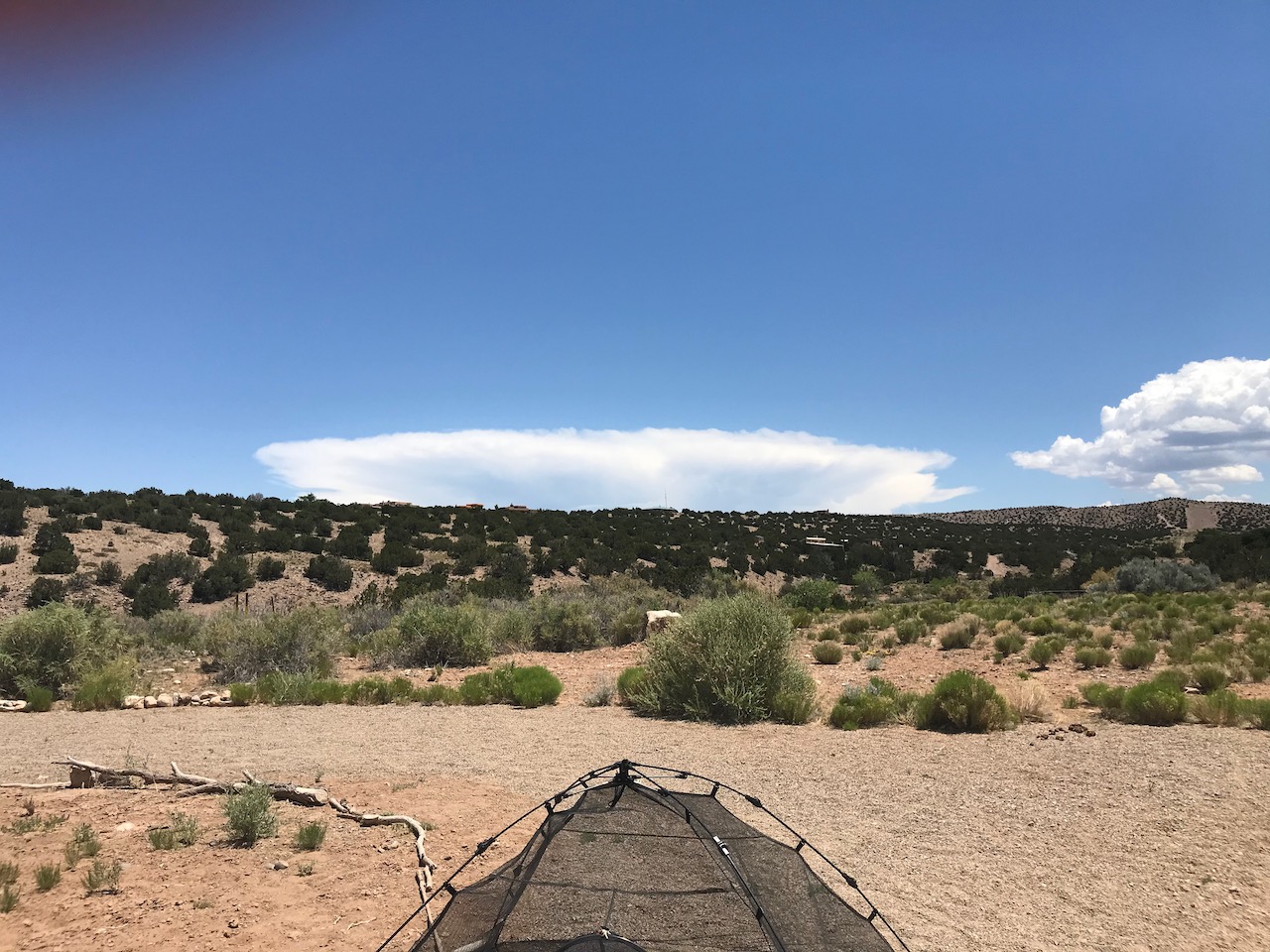
I love watching clouds, especially building storm clouds. They’re so pretty and visually dramatic. But I don’t really love seeing them when I know that right underneath, I need to be sitting ten feet up on an RV roof, ripping out an old vent, leaving a big hole, and having to get the new one dropped in, fastened, and the seams sealed before anything starts dropping out of those clouds!
I figured I’d better get busy. I know that with this big sky, you can see forever and everything looks closer than it actually is. But I couldn’t afford to misjudge the oncoming weather, because that would mean a serious mess.
I stole a quick glance at the radar on my phone, and it confirmed there was a storm building in the distance. In fact, our area was ringed with storm cells going up. But mercifully, the sky directly overhead was so far clear and bright.
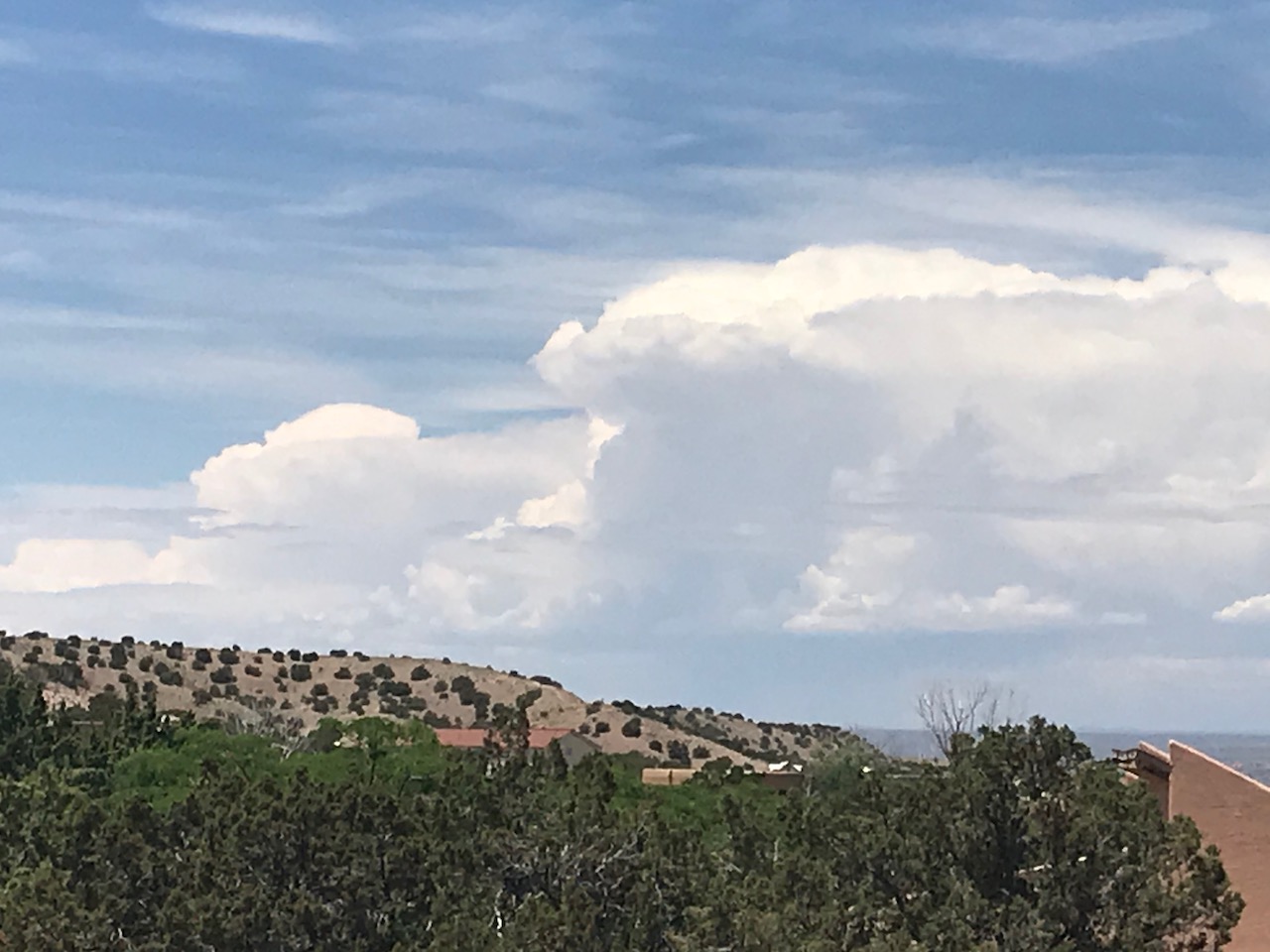
I borrowed my hosts’ taller ladder, since I don’t have one built into the back of my rig, and my 7-foot just wasn’t going to get me on the roof. Initially, I leaned it on the front of the rig. However, remembering the signs of water intrusion all along the front on the inside, I first pushed all along the roof front to make sure it would hold my weight.
So glad I did that! It bowed just under the weight of my hand, indicating that the earlier leaks (which I have since fixed) had not been inspected or repaired, and the wood understructure has likely suffered dry rot. That’s not a repair I’m prepared to take on any time soon, and since I’m planning to replace this rig soon, probably not at all. So I just decided to avoid putting any weight on the far front part of the roof and leave it at that.
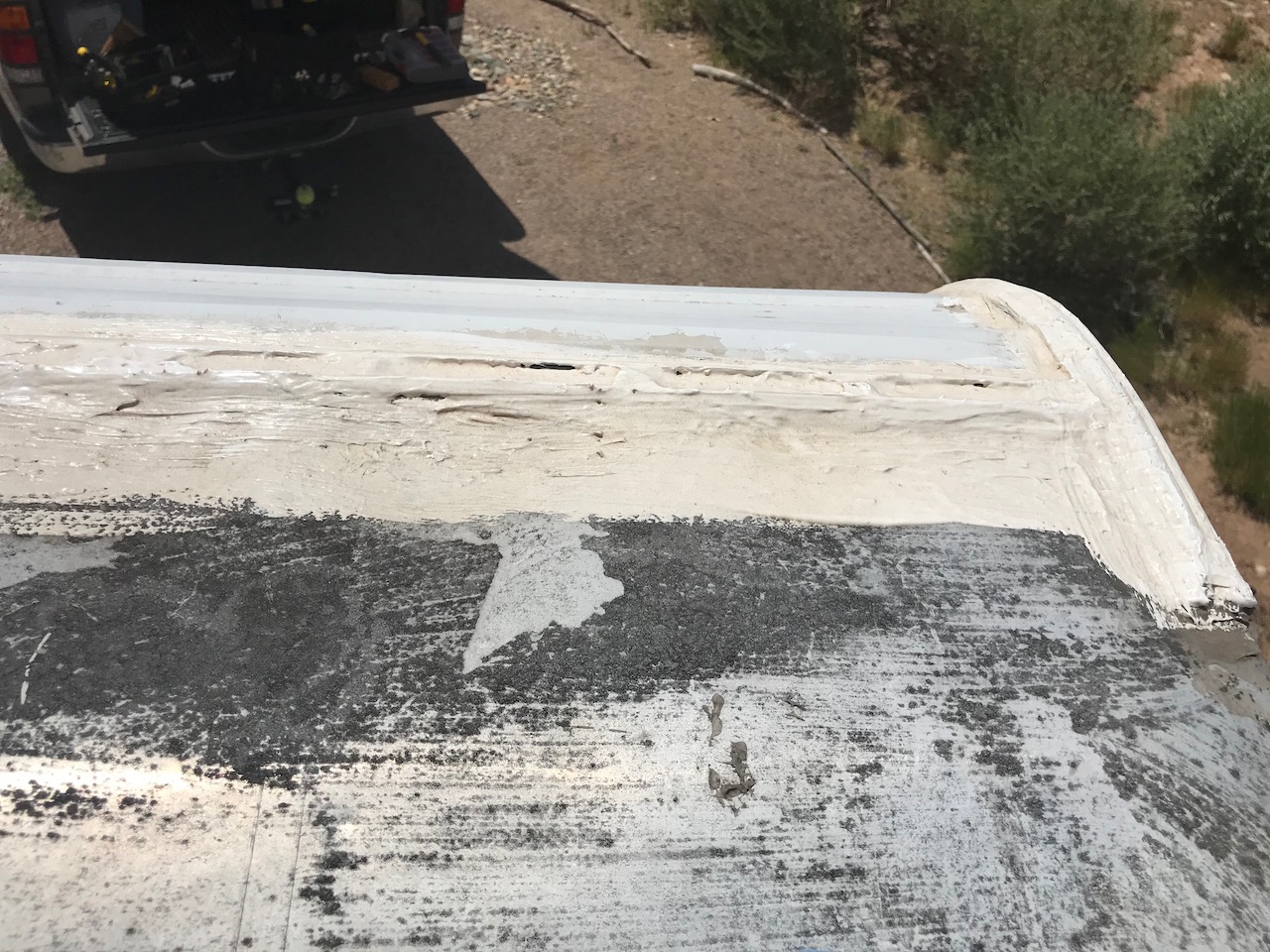
There are a few places along the old seal repair that look like they could use a fill job, so I’ll make that my next chore before recoating the roof with white rubber membrane. That will create a lighter surface to reflect the sun and lower the temperature by at least 20%, according to the information on the can.
I borrowed a large scrap of 1/2″ plywood to use as a platform on which I would sit while removing the old vent. It would work on the same principle of weight distribution that allows a steel ship to float on top of water. To my delight, it worked. After hoisting the wood onto to roof, I was able to slowly crawl up there, testing the area ahead of me by pushing on it. As I heard no groaning or cracking, I slid onto it and it felt solid enough. On top of the wood, I spread an old beach towel I use for anything where I need something soft that can get dirty. This would hopefully save me from butt splinters, as well as providing a little softness and shielding me a bit from the heat that was already rising off the aluminum surface.
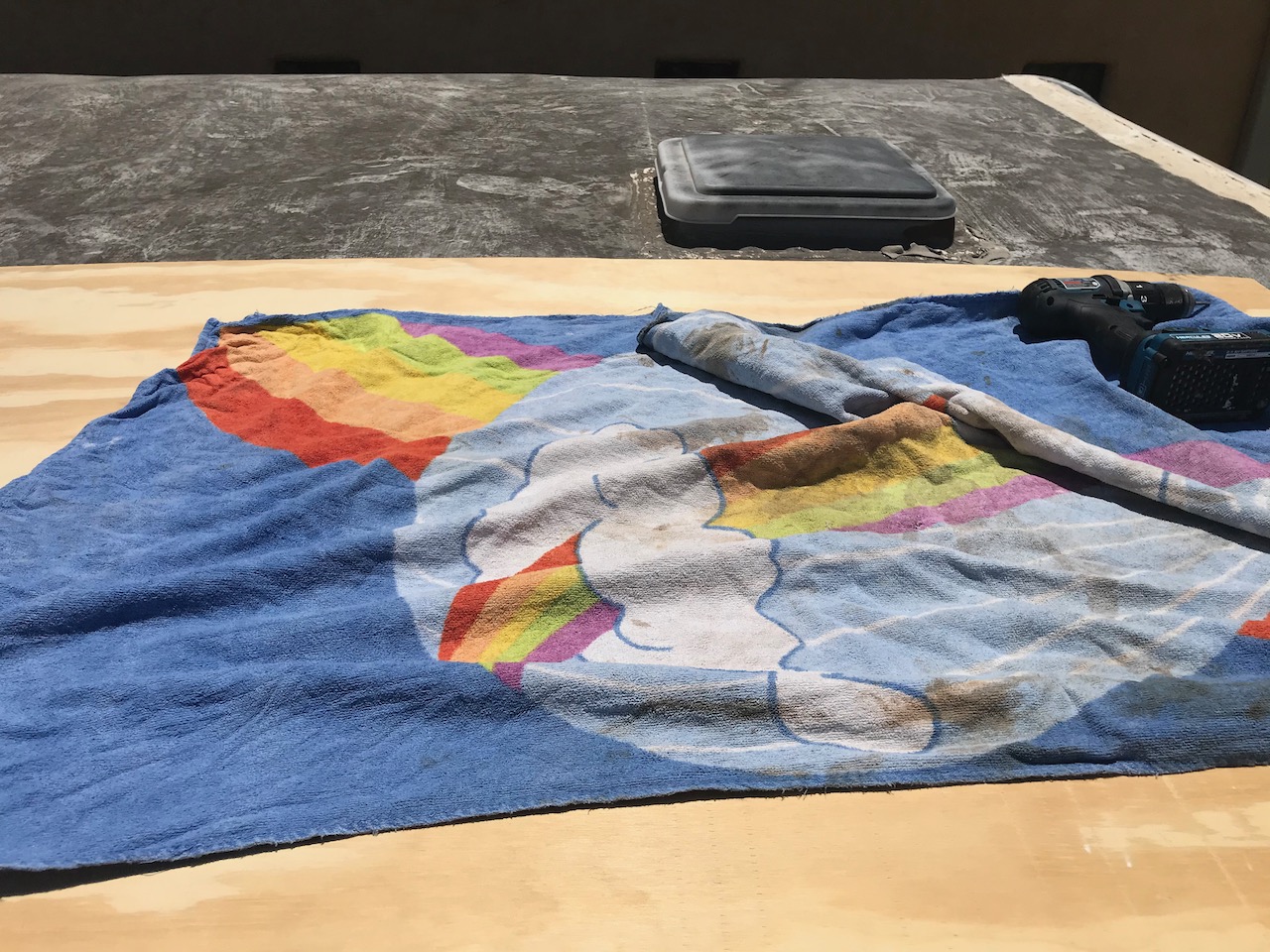
My friend, who had spotted me on the ladder as I climbed atop the roof and hoisted the wood up, now handed up to me a box of parts and supplies, the vent assembly, and a MaxxAir vent hood, which would allow me to leave the vent fan open and running even during rain. I had purchased that at a steep discount at the same time I had bought the fan.
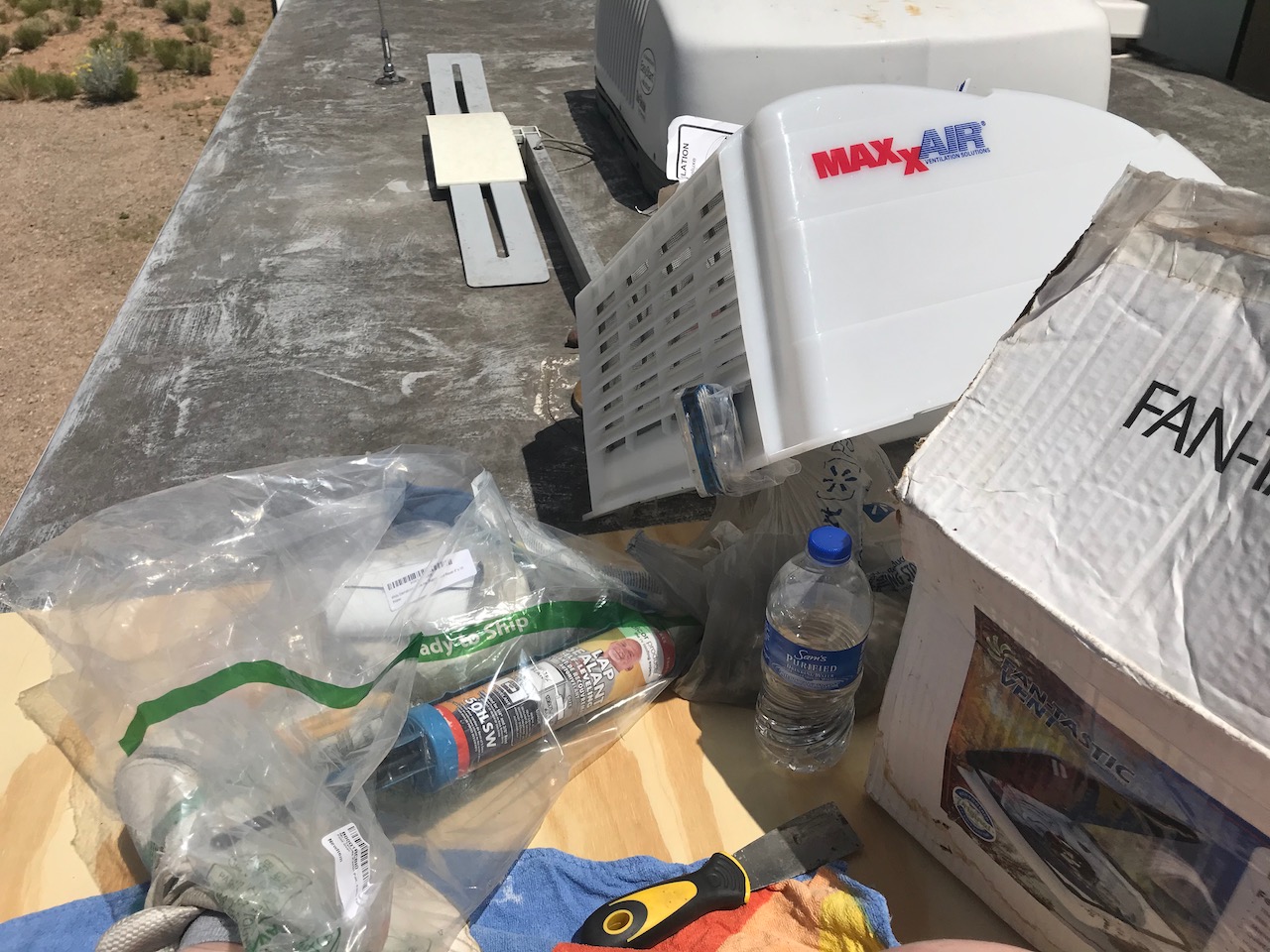
Every so often, I glanced up at the sky. All the storm clouds going up around me continued to grow, and with them, my concern that I might not finish the job before any rain arrived. That was good motivation to stay focused and git ’er done.
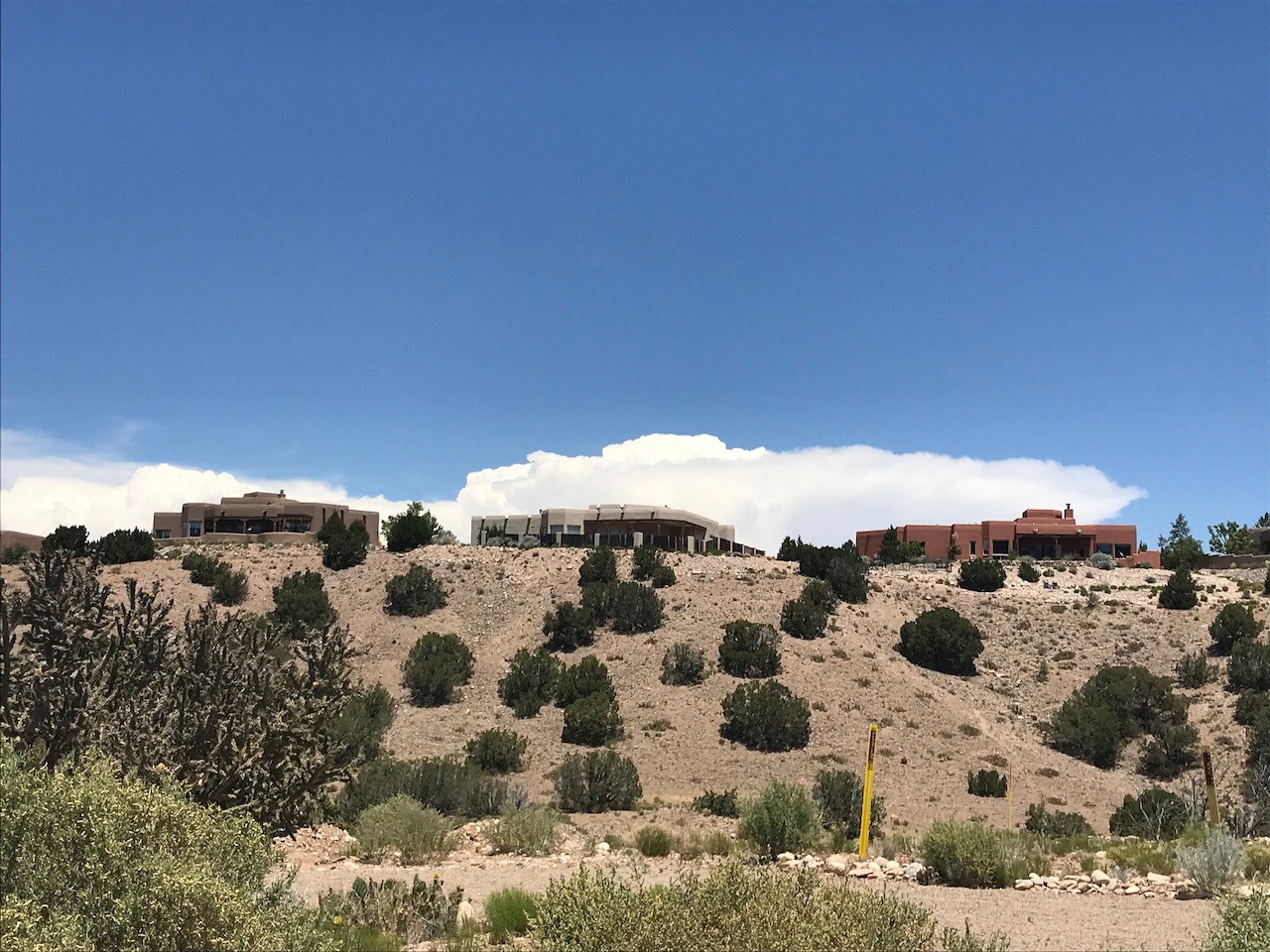
As the sun continued its morning rise over the top of the studio building, which had till then blocked the most direct rays, the roof began to become uncomfortably hot. I was grateful for having to forethought to use the wood platform and the towel on top of it. They worked together to keep my butt and thighs reasonably cool, at least enough not to feel like I couldn’t stand it up there.
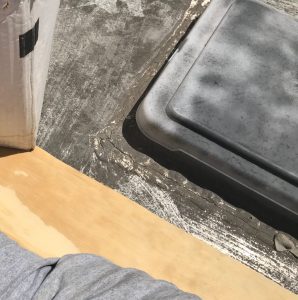
Now it was time to get down to some serious work. I used a putty knife to remove the nasty, cracked, dirty old Dicor lap sealant on top of the roof screws and around the outside of the roof vent flange. As the heat had softened it quite a bit, it was a fairly quick, if gooey, job.
Then I used my trusty drill driver to make quick work of removing the screws that attached it to the roof. I was careful to put them all in the same place, where I could quickly find them when it was time to attach the new one.
After that, it was easy to pry up the old vent by sliding the putty knife under the flange and gently lifting it up. Because I had some experience, I now knew that just about everything that’s attached to an RV has a layer of butyl tape under it. This thick, sticky putty never hardens, acting as a flexible gasket to keep water out of the interior.
The only problem is that the very characteristic that makes it great gasket material also makes it a sticky mess to remove. So it was more scraping with the putty knife, being careful not to damage or puncture the thing aluminum roofing membrane. Finally, I had it scraped clean, and used some cleaner meant to prep the surface for sticky things to get it really shiny and clear of dirt or grease, so the new gasket and Dicor would adhere well to the roof.
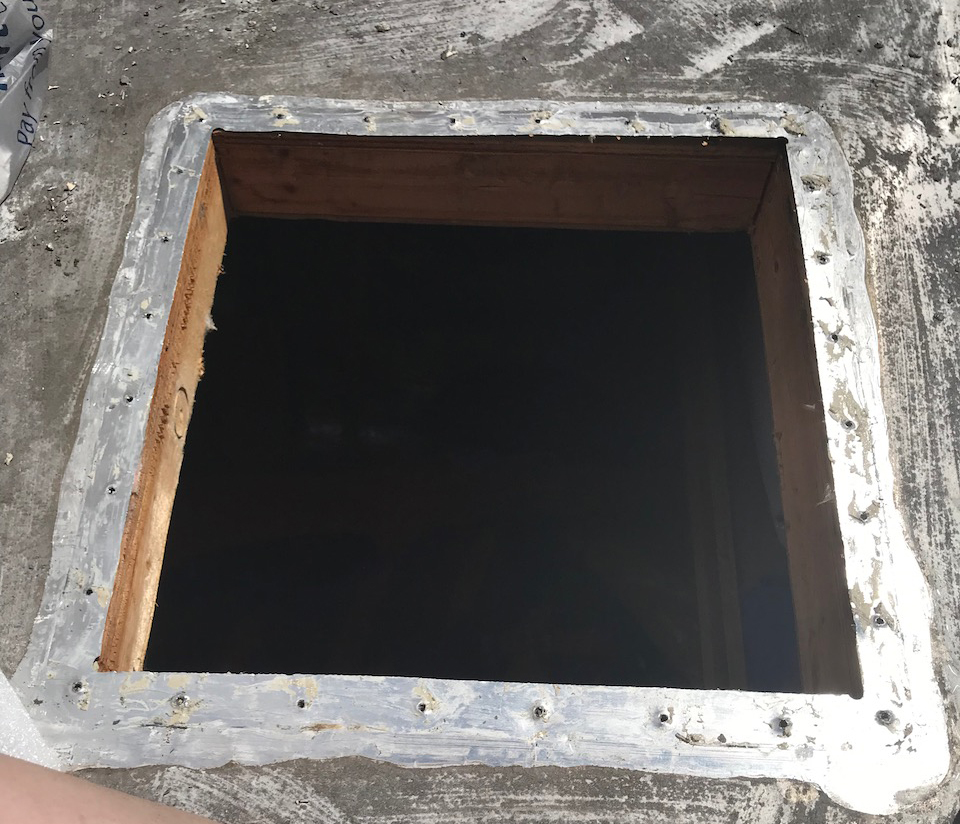
I had known that my cat, Biscuit, was somewhere below me, probably watching the whole time. She’s a very curious and intelligent cat, and sure enough, when I put my phone down through the roof hole and took a picture of her, she was yelling at me to hurry up already!
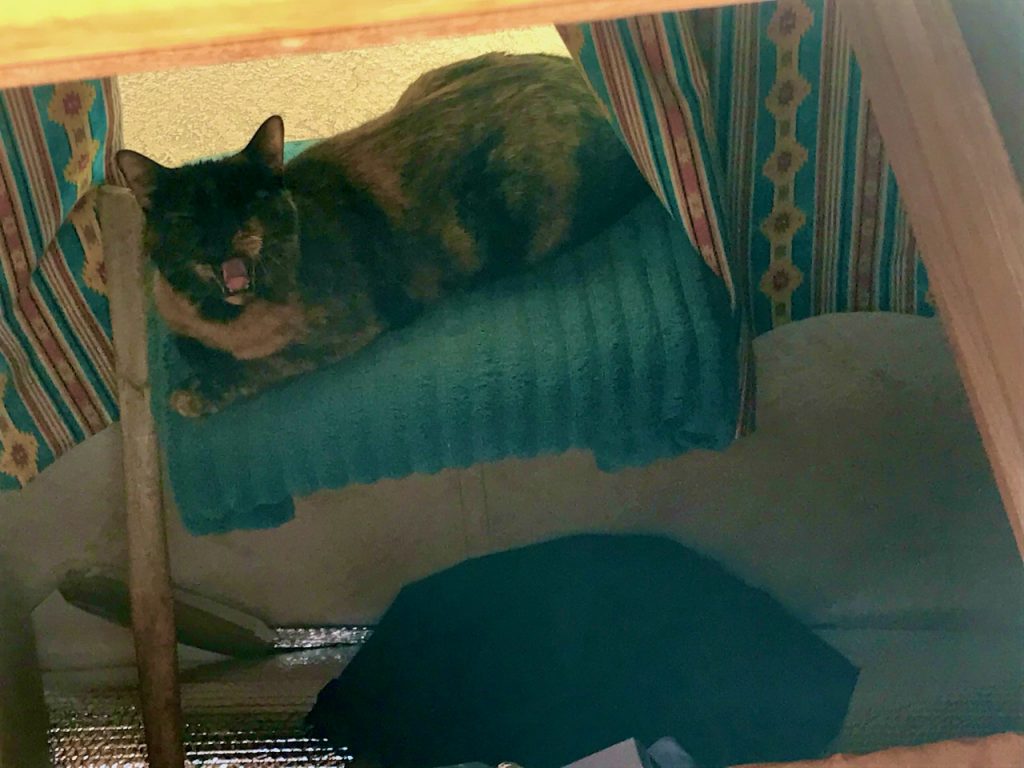
The sky was starting to look genuinely worrisome at this point, and I hurried to drop the new vent fan assembly into the hole and place new strips of butyl tape around the opening, which I cleaved from the roll with the putty knife.
It was getting truly hot now, well into the high 80s. The butyl tape had heated up and was begining to cling to the crepe paper carrier, making it difficult to remove all in one piece. That’s a bad thing, because you want as few openings as possible anywhere in the installation, where water might eventually find its way inside. It was a good lesson for future jobs to keep the butyl tape in a cool place until needed.
I proceeded to screw in the new assembly. There were fewer holes in the new one than the original, so I was glad for the thick layer of butyl tape, which would settle down into the unused holes as I tightened the screws, and plug them.
Then I used my cartridge gun to apply a thick layer of Dicor self-leveling lap sealant over the top of the screw heads and along the seam between the vent flange and the roof surface. I apologize for not getting any shots of this process, but by now I was truly racing the storm and just wanted to get finished before any rain arrived. However, there are tons of YouTube videos showing this entire process if you really need to see it done right. Here’s one I watched before attempting it myself.

Satisfied that I had everything snugged down and sealed up tight, I texted my friend to come back and hold the ladder for me. While I waited for her, I gathered all the old junk I removed into the cardboard box, and put my tools and cleaning supplies on top of it. In perfect time, my friend arrived and climbed the ladder. I handed the box down to her, slid carefully off the roof, then followed her down the ladder.
I hadn’t finished the job by attaching the MaxxAir Vent Cover, but that would have to wait for another day when I wasn’t racing a storm. It figures, after two years, the day I finally picked would be one in which rain materialized unexpectedly.
As we put away the ladder and the wood and I headed inside to finish the installation, I was glad I had gotten down off the roof when I did. The sky looked really threatening now.
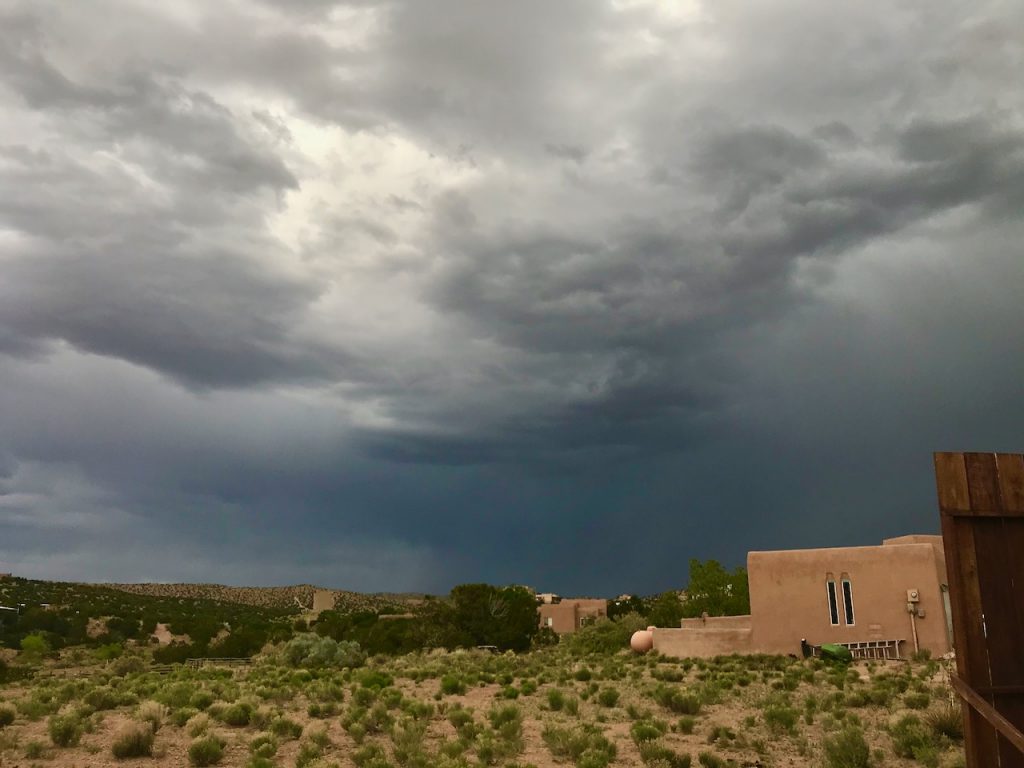
I went inside to the cool, where I had left the air conditioning on even though I’d had a hole in the roof. I knew I would be hot after the roof work. I hadn’t realized, apparently, when I was up there how hot it actually was. I had drunk a whole bottle of water in the hour or so I was up there.
Nevertheless, once I got into the cool iside the trailer, I suddenly felt a little queasy. I was sweating profusely, and my skin felt clammy. Fortunately, I immediately recognized it as the beginnings of heat exhaustion. I grabbed a bottle of water off the counter, where I keep some for when I don’t really want something too cold, and drank that slowly but steadily.
After about half a bottle, I wiped my face off and laid down on the bed for a bit until the nausea went away and I felt more steady. I was no longer worried about racing the storm, since the rest of the work would be inside. In the next post, I show the remainder of that work.

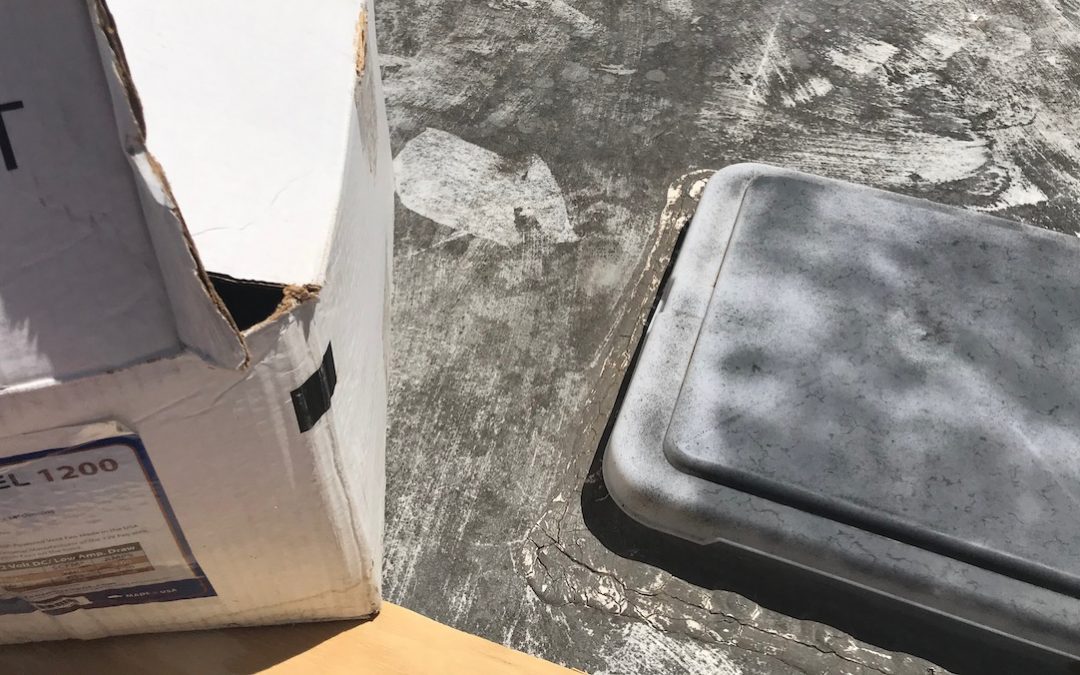
Recent Comments